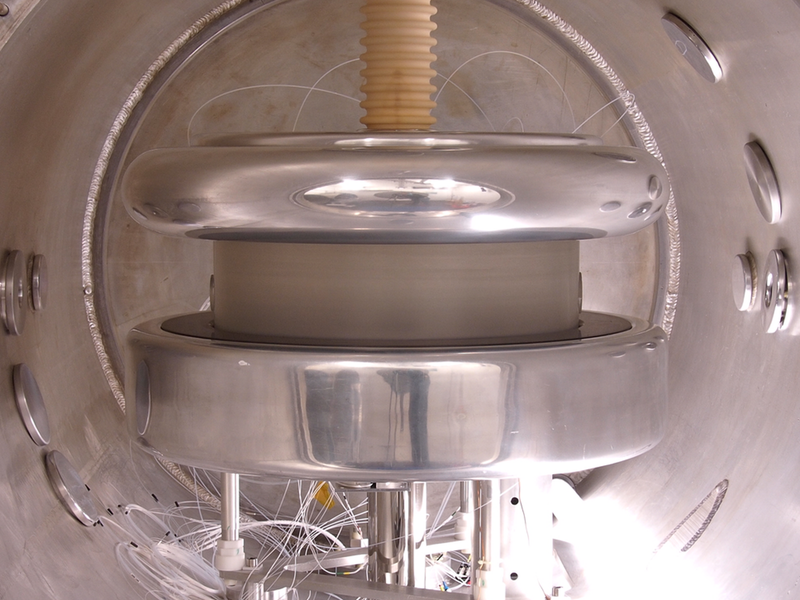Ultracold Neutrons Measure Magnetic Field
A new technique measures the range of energies in a cloud of ultracold neutrons and also detects variations in the magnetic field applied to the cloud with an unprecedented degree of sensitivity. The method uses a trick borrowed from medical imaging and could significantly benefit experiments searching for a neutron electric dipole moment, which in turn could reveal why there is an imbalance between matter and antimatter.
One of the biggest unanswered questions about the neutron concerns its “roundness”—whether its electric charge is distributed with perfect spherical symmetry or is, say, distributed with slightly more positive charge at one end and more negative charge at the other. Such an asymmetry is called an electric dipole moment (EDM). A nonzero neutron EDM is predicted by some theories that explain the differing amounts of matter and antimatter in the early Universe, so measuring it could point the way to more comprehensive theories. But so far no neutron EDM has been found, despite efforts dating back to the 1950s [1].
A neutron has a spin related to its known magnetic dipole moment, so it rotates (precesses) in a magnetic field; with an EDM, it would also precess in an electric field. The EDM experiment measures the neutron's precession in a combined electric and magnetic field (comparing parallel with antiparallel fields). But this measurement is often thwarted by unknown variations in what should be a perfectly uniform magnetic field. For example, there could be a vertical gradient, meaning that the field slightly increases or decreases in strength going from the bottom to the top of the neutron chamber.
Now a team led by Philipp Schmidt-Wellenburg of the Paul Scherrer Institute in Switzerland has found a way to measure such tiny gradients with unprecedented accuracy and thus reduce one of the biggest systematic errors in EDM experiments.
The trapped neutrons in these experiments are typically ultracold (temperatures around 3 millikelvin) and move so slowly that they are noticeably affected by the force of gravity. Like bouncing ping-pong balls, the neutrons with the largest speeds (energies) bounce the highest and experience, on average, a slightly weaker magnetic-field strength than the lower-energy neutrons at the bottom of the container. Field strength determines precession frequency, so the frequency varies with neutron height and energy, an effect first theoretically described last year [2].
The team applied a vertical magnetic-field gradient to their cylinder containing ultracold neutrons and measured the field with the low accuracy available with magnetic sensors spaced around the chamber. The researchers then aligned all of the neutron spins with an electromagnetic pulse. Schmidt-Wellenburg describes this pulse as the “whistle” that starts a running race, where the runners are the neutron spins precessing in the magnetic field. During the race, each neutron precesses to a different degree, depending on its average height. A second pulse turned the runners around. By measuring the progress of the neutron spins—the overall spin alignment, or polarization, of the population—after a fixed amount of time, the researchers reconstructed the neutron height distribution.
This method is akin to MRI, where precession of nuclei in a known magnetic-field gradient leads to a map of the density of those nuclei. By accounting for gravity, the team derived the neutron energy distribution, which could be useful for other experiments that measure the lifetime of the neutron.
To improve on the accuracy of their rough measurements of the magnetic-field gradient, the researchers made polarization measurements in three different field gradients. They fit the data to their model and came up with a fixed gradient correction with a precision of about a picotesla per centimeter, which is about 8 times more precise than previous measurements. With this new level of accuracy and precision, Schmidt-Wellenburg and his colleagues have already started collecting data in what should be a more sensitive search for the neutron EDM.
This work is a “great example of how different fields can learn from one another in order to make a breakthrough,” says Jeffery Martin, of the University of Winnipeg in Canada, referring to the use of an MRI principle in EDM experiments. Many research groups, including Martin’s, are currently building up bigger samples of ultracold neutrons in order to do similar experiments in a bid to set the new limit on the “roundness” of the neutron.
This research is published in Physical Review Letters.
–Tamela Maciel
Tamela Maciel is a freelance science writer in Leicester, UK.
References
- J. H. Smith, E. M. Purcell, and N. F. Ramsey, “Experimental Limit to the Electric Dipole Moment of the Neutron,” Phys. Rev. 108, 120 (1957).
- P. G. Harris, J. M. Pendlebury, and N. E. Devenish, “Gravitationally Enhanced Depolarization of Ultracold Neutrons in Magnetic-Field Gradients,” Phys. Rev. D 89, 016011 (2014).





